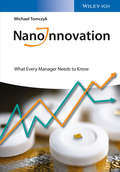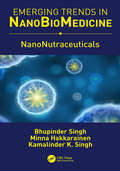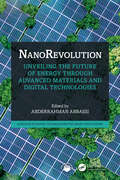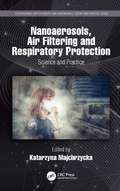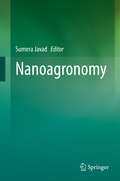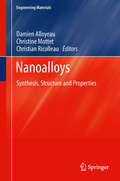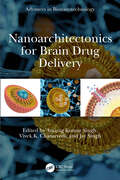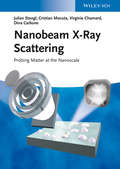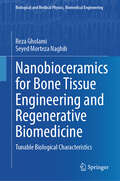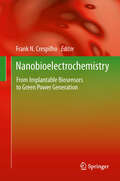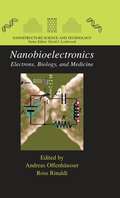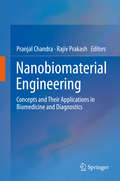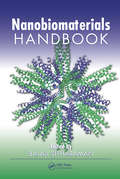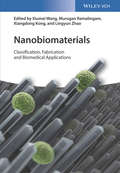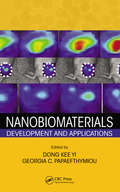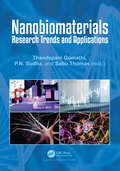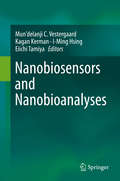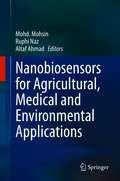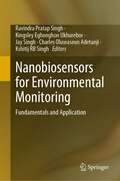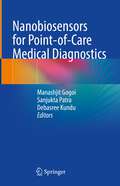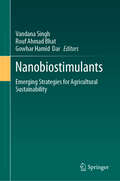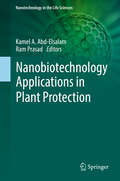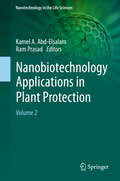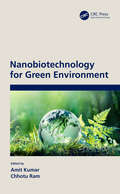- Table View
- List View
NanoInnovation
by Michael TomczykThe innovative, easy-to-read guide to the "nanoscale revolution", this book provides essential knowledge of nanotechnology and clearly explains the fundamentals of nanomaterials and properties.Written by a technology pioneer, the book shows feasible strategies for managers in nanotech companies, including how to communicate with nanotech engineers and developers, coupled with examples of emerging technologies and innovations. A level-headed discussion of critical issues for decision makers and stakeholders rounds off the contents.The result is a vivid, yet realistic look at nanotechnology, providing orientation in the nanoworld: major lines of research, key players in R&D, as well as social, economic and political issues.
NanoMind: Exploring Synergies in Nanotechnology and Machine Learning (Information Systems Engineering and Management #27)
by Alvaro Rocha Shubham Mahajan Paras Chawla Susanta Das Debanjali Barman RoyNanoMind" serves as a captivating exploration at the crossroads of nanotechnology and machine learning, revealing the profound synergies between these two groundbreaking fields. At its core, the book is a guided tour through the intricate realms of nanoscale materials and artificial intelligence, illuminating their combined potential to reshape the landscape of innovation. The journey begins with an introductory chapter, setting the stage for the convergence of nanotechnology and machine learning. Readers are introduced to the fundamental principles and applications of nanoscale materials, laying the groundwork for a deeper understanding of the nano-world. Simultaneously, the basics of machine learning are demystified, providing a comprehensive overview of the methodologies and concepts that underpin AI. "Nanoscale Sensing and Imaging" takes readers into the realm of advanced technologies, showcasing how machine learning enhances our ability to sense and image materials at the nanoscale. The narrative then seamlessly transitions to the creation and optimization of materials with nano-enhancements in "Nano-Enabled Materials." This section demonstrates how the marriage of nanotechnology and machine learning can lead to the development of materials with unprecedented properties, fostering innovation in diverse industries. The exploration extends into the field of healthcare with "Machine Learning in Nanomedicine," unveiling how AI at the nanoscale is transforming diagnostics, drug delivery, and personalized medicine. "Quantum Computing and Nanotechnology" delves into the cutting-edge intersection of quantum computing, nanotech, and machine learning, showcasing the potential for revolutionary advancements in computation and problem-solving. However, the journey isn't without its challenges. The book devotes a section to "Challenges and Ethical Considerations," addressing the complexities and ethical dimensions associated with the convergence of nanotechnology and machine learning. This discussion ensures that readers are equipped to navigate the ethical landscape responsibly.
NanoNutraceuticals
by Bhupinder SinghThis book will be a comprehensive account of the various facets of nutraceuticals domain. The peruser of this book will find details on various nanotech approaches to nutraceuticals, prebiotics and probiotics, along with their specific applications.
NanoRevolution: Unveiling the Future of Energy through Advanced Materials and Digital Technologies (Advances in Digital Technologies for Smart Applications)
by Abderrahman AbbassiAs the global push toward energy accelerates, NanoRevolution: Unveiling the Future of Energy through Advanced Materials and Digital Technologies brings forward a powerful vision of how advanced materials and digital technologies are redefining energy solutions. This comprehensive resource navigates the frontiers of nanotechnology, artificial intelligence (AI), and IoT applications within the renewable energy sector, presenting innovative strategies that address today’s most pressing energy challenges.Across 15 chapters, NanoRevolution covers transformative advancements in photovoltaic and energy storage technologies. It explores the application of density functional theory (DFT) in developing high-efficiency, lead-free solar cells, new methodologies for enhancing MXenes-based materials, and emerging AI-powered solutions for energy optimization and predictive maintenance. The book also examines IoT-driven innovations in photovoltaic systems and provides a high-level overview of blockchain's potential in secure energy transactions.This book is an invaluable guide for researchers, engineers, and industry professionals focused on next-generation energy solutions, offering both theoretical depth and practical applications to drive progress toward a sustainable energy future.
Nanoaerosols, Air Filtering and Respiratory Protection: Science and Practice (Occupational Safety, Health, and Ergonomics)
by Katarzyna MajchrzyckaRecent toxicological studies show that nanoparticles released in technological processes and combustion processes outside industry can be dangerous for humans especially when entering the body through the mouth and nose. In connection with the above, the use of adequately effective respiratory protection equipment is of great importance in prophylactic and preventive activities. The first part of Nanoaerosols, Air Filtering and Respiratory Protection: Science and Practice refers to the general phenomena of filtration described on the basis of the authors’ own experience and international reports. The book also includes a description of the respiratory system and principles of its functioning and the accumulation of aerosol particles. It goes on to discuss technological innovations regarding the production of filtering materials for protection against nanoparticles and the latest test methods. Finally, the book contains information about the proper selection and use of respiratory protective devices against airborne nanoparticles in the workplace and everyday life. Special attention is paid to proper fit procedures as well as use and maintenance activities of such devices. The content of the book with rich illustrative material has been presented so that it can be used by health and safety experts, students as well as employers, employees and private users of respiratory protective devices. "Through a comprehensive approach to the subject of the work, the authors present theoretical foundations as well as practical solutions that are used in the research and development of personal respiratory protection. The complementarity of the information contained in the book will allow the reader to become familiar with a wide range of knowledge related to the design and manufacture as well as assessment of properties and procedures for the use of respiratory protection against the adverse effects of aerosols, including air contaminated with nanoparticles and microparticles. In my opinion the book is a valuable part of the series Occupational Safety, Health, and Ergonomics: Theory and Practice, published by Taylor & Francis." —Maciej Boguń, ŁUKASIEWICZ – The Textile Research Institute, Łódź
Nanoagronomy
by Sumera JavadIn this age of population explosion and depleting natural resources, this book offers new techniques to produce more from agricultural crops at a lower cost. The field of agronomy addresses this issue and interacts with the fields of agriculture, botany, and economics. Nanotechnology and nanoparticles play a role in agronomy. This book will join the techniques from both fields to construct one comprehensive book. Students of agriculture, physics, nanotechnology, and plant sciences will benefit equally from this work.
Nanoalloys
by Christine Mottet Christian Ricolleau Damien AlloyeauBimetallic nanoparticles, also called nanoalloys, are at the heart of nanoscience because of their ability to tune together composition and size for specific purposes. By approaching both their physical and chemical properties, Nanoalloys: Synthesis, Structure & Properties provides a comprehensive reference to this research field in nanoscience by addressing the subject from both experimental and theoretical points of view, providing chapters across three main topics: Growth and structural properties Thermodynamics and electronic structure of nanoalloys Magnetic, optic and catalytic properties The growth and elaboration processes which are the necessary and crucial part of any experimental approach are detailed in the first chapter. Three chapters are focused on the widely used characterization techniques sensitive to both the structural arrangements and chemistry of nanoalloys. The electronic structure of nanoalloys is described as a guide of useful concepts and theoretical tools. Chapters covering thermodynamics begin with bulk alloys, going to nanoalloys via surfaces in order to describe chemical order/disorder, segregation and phase transitions in reduced dimension. Finally, the optical, magnetic and catalytic properties are discussed by focusing on nanoparticles formed with one element to track the modifications which occur when forming nanoalloys. The range and detail of Nanoalloys: Synthesis, Structure & Properties makes it an ideal resource for postgraduates and researchers working in the field of nanoscience looking to expand and support their knowledge of nanoalloys.
Nanoarchitectonics for Brain Drug Delivery (Advances in Bionanotechnology)
by Jay Singh Vivek K. Chaturvedi Anurag Kumar SinghThis book discusses basics of brain diseases and the role of nanobiotechnology in existing treatment options for neurodegenerative disorders. It begins with an overview of brain diseases and the need for novel drug-delivery approaches. It highlights the current route for the intranasal advanced drug-delivery systems for brain diseases. It also discusses innovative categories of drug-delivery systems, including mesoporous silica nanoparticles, polymeric nanocarriers, and lipid-based nanocarriers through multi-responsive DDSs and their implications in brain disorders.Features: Includes an overview of brain diseases and highlights the need for novel drug-delivery approaches Focuses on theoretical aspects of advanced drug-delivery systems for brain diseases including challenges and progress in nose-to-brain delivery Provides an overview of technological approaches and their implications for neurodegenerative disorders, central nervous system (CNS), and brain drug delivery in brain cancer Discusses key advances in the development of polymer nanoparticles for drug delivery to the CNS Reviews the role of herbal medicines and naturally derived polymeric nanoparticle for the treatment of neurodegenerative disorders This book is aimed at graduate students and researchers in biomedical engineering, biotechnology, drug delivery, and neurology.
Nanobeam X-Ray Scattering: Probing Matter at the Nanoscale
by Dina Carbone Julian Stangl Virginie Chamard Cristian MocutaA comprehensive overview of the possibilities and potential of X-ray scattering using nanofocused beams for probing matter at the nanoscale, including guidance on the design of nanobeam experiments. <P><P>The monograph discusses various sources, including free electron lasers, synchrotron radiation and other portable and non-portable X-ray sources. For scientists using synchrotron radiation or students and scientists with a background in X-ray scattering methods in general.
Nanobioceramics for Bone Tissue Engineering and Regenerative Biomedicine: Tunable Biological Characteristics (Biological and Medical Physics, Biomedical Engineering)
by Reza Gholami Seyed Morteza NaghibThis book presents the tunable biological characteristics of nanobioceramics and focuses on some challenges in bone tissue engineering and regenerative medicine. Synthetic composite-based materials and scaffolds should be biodegradable, biocompatible and supply sufficient structural aid for cell migration, along with oxygen, waste, and nutrient carriage to accelerate bone regeneration process and remodeling in defects. These properties may be reached by functioning tunable physical features, including absorption rate, degradation rate, modulus, porosity, and swelling by adjustments with the addition of ceramic phases and copolymers as synthetic composite scaffolds. Synthetic bioceramics seek to imitate the natural hydroxyapatite (HA) crystal creation located in bone. These ceramics, particularly calcium phosphates, have exhibited great osteoinductivity, osteoconductivity, and biocompatibility. Lately, silicon-based glass-ceramics have been investigated as a substitution of calcium phosphates. Several members of this collection exhibit high bioactivity, have attractive mechanical strength, and are known to increase cell proliferation, adhesion, and mineralization of extracellular matrix. Moreover, antibacterial properties of some nanostructured bioceramics established significant interests in avoiding implants rejection in surgery and biomedicine.
Nanobioelectrochemistry
by Frank N. CrespilhoNanobioelectrochemistry covers the modern aspects of bioelectrochemistry, nanoscience and materials science. The combination of nanostructured materials and biological molecules enables the development of biodevices capable to detect specific substances. Furthermore, by using the bioelectrochemistry approach, the interaction between bio-systems and nanostructured materials can be studied at the molecular level, where several mechanisms of molecular behavior are elucidate from redox reactions. The combination of biological molecules and novel nanomaterials components is of great importance in the process of developing new nanoscale devices for future biological, medical and electronic applications. This book describes some of the different electrochemical techniques that can be used to study new strategies for patterning electrode surfaces with enzymes, organelles, cells and biomimetic systems. Also, it focuses on how enzymes and microorganisms can be used as biological catalysts in fuel cells for green power generation. By bringing together these different aspects of nanobioelectrochemistry, this book provides a valuable source of information for many students and scientists.
Nanobioelectronics - for Electronics, Biology, and Medicine
by Ross Rinaldi Andreas OffenhäusserThe range of themes addressed in this book emphasize key aspects and the future perspectives of nano-bioelectronics. The book discusses the electronic coupling of DNA and proteins with electronic devices to build new information systems and to apply the systems as biosensors. The exploitation of networks of neurons connected with electronic devices in future information processing systems and the use of nano-objects to assess cellular function is also discussed in detail. The topics of these hybrid nano-bioelectronic systems are both interesting for fundamental research and to enhance industrial competitiveness through research, education, and transfer of technology.
Nanobiomaterial Engineering: Concepts and Their Applications in Biomedicine and Diagnostics
by Pranjal Chandra Rajiv PrakashThis book comprehensively documents the application of Nanobiomaterials in the field of bio-medicine and diagnostics technologies by involving classical concepts/examples. Nanobiotechnology is an emerging area which encompasses all the facets of research of nano and biomaterials with their interaction with biological systems. The book briefly summarizes the various types of Nanomaterial’s, and highlights the recent developments in the synthesis of the nanomaterials for the diagnostic and therapeutic biomedical applications. It skilfully reviews the utilization of the nanomaterials alone or in combination with other bio-molecules as a contrast enhancer in in-vivo imaging, Nano-Theranostics, drug delivery, and sensing transducer matrix. It also discusses the current research on designing of the new Nanobiomaterials and their implementation in numerous fields including bio-medicine and diagnostics. Finally, it summarizes the future prospects and the commercial viability of Nanobiomaterials in the human health care.
Nanobiomaterials Handbook
by Balaji SitharamanNanobiomaterials exhibit distinctive characteristics, including mechanical, electrical, and optical properties, which make them suitable for a variety of biological applications. Because of their versatility, they are poised to play a central role in nanobiotechnology and make significant contributions to biomedical research and healthcare. Nanobio
Nanobiomaterials: Classification, Fabrication and Biomedical Applications
by Murugan Ramalingam Xiu-Mei Wang Xiangdong Kong Lingyun ZhaoWritten by an international team of editors and contributors from renowned universities and institutes, this book addresses the latest research in the field of nanobiomaterials, covering nanotechnologies for their fabrication, developments in biomedical applications, and the challenges of biosafety in clinic uses. Clearly structured, the volume defines the scope and classification of the field, resulting in a broad overview from fundamental principles to current technological advances, and from materials synthesis to biomedical applications along with future trends.
Nanobiomaterials: Development and Applications (Advances in Materials Science and Engineering)
by Dong Kee Yi Georgia C. PapaefthymiouThere is a continuous exchange of ideas taking place at the border of the biological and physical sciences in many areas of nanoscience. Nanotechnology uses biomimetic or bio-inspired processes to produce nanosized materials for applications in biology and other fields. In return, the fruits of nanotechnology are applied to expanding areas of biome
Nanobiomaterials: Research Trends and Applications
by Sabu Thomas P. N. Sudha Thandapani GomathiNanobiomaterials: Research Trends and Applications – Biomaterials are derived from natural resources such as plants, animals and marine sources. These biomaterials have advanced applications, across a range of key industries due to their low cost, being easy to process, being biocompatible and so on. The modification of biomaterials in the nanoform enhances their applications. The book begins with an overview of nanobiomaterials, processing, classifications, fabrication and sustainability. In-depth chapters in Part I address the most recent methods and techniques for physicochemical characterisation, processing of blends and composites based on nanomaterials, and separation. Chapters in Part II focus on the biological and biomedical applications specifically in antimicrobial chemotherapy, drug delivery, tissue engineering, cancer therapeutics, robust biosolar cells, and 3D printing. The chapters in Part III mostly focus on environmental applications, including wastewater treatment, water desalination, bioremediation, and agricultural uses. The book is extremely useful for scientists, R&D specialists, designers, and engineers across sectors and disciplines who are interested in using biopolymers for parts and products.
Nanobiosensors and Nanobioanalyses
by Mun'Delanji C. Vestergaard Kagan Kerman I-Ming Hsing Eiichi TamiyaThis book provides a comprehensive review of established, cutting-edge, and future trends in the exponentially growing field of nanomaterials and their applications in biosensors and bioanalyses. Part I focuses on the key principles and transduction approaches, reviewing the timeline featuring the important historical milestones in the development and application of nanomaterials in biosensors and bioanalyses. Part II reviews various architectures used in nanobiosensing designs focusing on nanowires, one- and two-dimensional nanostructures, and plasmonic nanobiosensors with interferometric reflectance imaging. Commonly used nanomaterials, functionalization of the nanomaterials, and development of nanobioelectronics are discussed in detail in Part III with examples from screen-printed electrodes, nanocarbon films, and semiconductor quantum dots. Part IV reviews the current applications of carbon nanotubes, nanoneedles, plasmonic sensors, electrochemical scanning microscopes, and field-effect transistors with the future outlook for emerging technologies. Attention is also given to potential challenges, in particular, of taking these technologies at the point-of-need. The book concludes by providing a condensed summary of the contents, with emphasis on future directions. Nanomaterials have become an essential part of biosensors and bioanalyses in the detection and monitoring of medical, pharmaceutical, and environmental conditions, from cancer to chemical warfare agents. This book, with its distinguished editors and international team of expert contributors, will be an essential guide for all those involved in the research, design, development, and application of nanomaterials in biosensors and bioanalyses.
Nanobiosensors for Agricultural, Medical and Environmental Applications
by Altaf Ahmad Mohd. Mohsin Ruphi NazThis informative book compiles the most up-to-date applications of nanobiosensors in fields ranging from agriculture to medicine. The introductory section describes different types of nanobiosensors and use of nanobiosensors towards a sustainable environment. The applications are divided into four broad sections for easy reading and understanding. The book discusses how manipulation, control and integration of atoms and molecules are used to form materials, structures, devices and systems in nano-scale. Chapters in the book shed light on the use of nanosensors in diagnostics and medical devices. Application in food processing as well as in cell signaling is also described. Nanobiosensors have immense use, and this book captures the most important ones.
Nanobiosensors for Environmental Monitoring: Fundamentals and Application
by Charles Oluwaseun Adetunji Ravindra Pratap Singh Kshitij Rb Singh Kingsley Eghonghon Ukhurebor Jay SinghThis book entails detailed information on the utilization of nanobiosensor as an effective technology for the effective detection, monitoring, and management of environmental contaminations to ensure its sustainability and humanity's well-being. The higher level of anthropogenic action has been identified as a threat to humankind's existence due to the higher level of xenobiotic and toxic substances that could interrupt the normal ecosystem. This has prompted numerous agencies both locally and internationally that could play a significant role in environmental pollution mitigation. The application of nanobiosensor has been identified as a sustainable technique that could be applied to ensure proper detection and identification of several environmental contaminants. Nanomaterial’s possible applications created an innovative domain called nanomaterials based biosensors machinery as one of nanotechnology's ultimate sub-divisions. The application of nanomaterials based biosensors machinery and their advancements could be applied globally to resolve numerous environmental sectors' challenges to guarantee the environment's quality and safety. The book will be an excellent collection of reviews based on contemporary research and developments on nanomaterials utilization and applications in environmental monitoring along with their prospects. The book will attempt to give a comprehensive idea of nanomaterial concepts for nanobiosensors applications in an environmental context to help students, researchers, and professionals/practitioners recognize nanomaterials' significance in the environmental domain. The book will also help understand and address the environmental sectors' complications via nanomaterials' utilization and applications. Hence, this book will serve as a textbook and will help students, professionals/practitioners, scientists, researchers, and academicians in various research domains.
Nanobiosensors for point-of-care medical diagnostics
by Manashjit Gogoi Sanjukta Patra Debasree KunduThis book examines the role of nanobiosensors in point-of-care applications for personalized healthcare and management. It begins by discussing various biomaterials that are used for the development of biosensors in medical diagnostics, and reviews advances in their fabrication and the miniaturization of biosensor devices for lab-on-chip analysis. In turn, it explores the rapidly evolving applications of nanomaterials in the context of biomaterial diagnostics. The book also explores the immense potential of biosensors in medical diagnostics, where they are increasingly being used to detect a wide range of biomolecules and biomarkers. In closing, it discusses the current challenges and outlines the future role of nanobiosensors in the development of next-generation point-of-care applications.
Nanobiostimulants: Emerging Strategies for Agricultural Sustainability
by Vandana Singh Rouf Ahmad Bhat Gowhar Hamid DarThe book describes how nanobiostimulants, which are nanoscale materials that can enhance plant growth and productivity, have the potential to revolutionize sustainable agriculture practices. The book covers a wide range of topics, including the properties and functions of nanobiostimulants, the mechanisms behind their effects on plant growth, and the potential risks associated with their use. It also discusses how nanobiostimulants can be used to improve soil health and nutrient uptake, enhance plant resistance to environmental stresses, and increase crop yields. Overall, the book provides a comprehensive overview of the emerging field of nanobiostimulants and its potential applications in sustainable agriculture. It will be of interest to researchers, students, and professionals in the fields of agriculture, nanotechnology, and environmental science.
Nanobiotechnology Applications in Plant Protection (Nanotechnology in the Life Sciences)
by Ram Prasad Kamel A. Abd-ElsalamNanotechnology can target specific agricultural problems related to plant pathology and provide new techniques for crop disease control. Plant breeders and phytopathologists are needed who can apply nanogenomics and develop nanodiagnostic technologies to accurately advance the improvement process and take advantage of the potential of genomics. This book serves as a thorough guide for researchers working with nanotechnology to address plant protection problems.Novel nanobiotechnology methods describe new plant gene transfer tools that improve crop resistance against plant diseases and increase food security. Also, quantum dots (QDs) have emerged as essential tools for fast and accurate detection of particular biological markers. Biosensors, QDs, nanostructured platforms, nanoimaging, and nanopore DNA sequencing tools have the potential to raise sensitivity, specificity, and speed in pathogen detection, thereby facilitating high-throughput analysis and providing high-quality monitoring and crop protection. Also, this book deals with the application of nanotechnology for quicker, more cost-effective, and precise diagnostic procedures of plant diseases and mycotoxins. Applications of nanotechnology in plant pests and disease control, antimicrobial mechanisms, pesticides remediation and nanotoxicity on plant ecosystem and soil microbial communities are discussed in detail. Moreover, the application of specific nanomaterials including silver, copper, carbon- or polymer-based nanomaterials and nanoemulsions are also discussed. Crops treated with safe nanofertilizers and nanopesticides will gain added value because they are free of chemical residues, decay and putative pathogens for human health, sustaining the global demand for high product quality.
Nanobiotechnology Applications in Plant Protection: Volume 2 (Nanotechnology in the Life Sciences)
by Ram Prasad Kamel A. Abd-ElsalamNanobiotechnology Applications in Plant Protection: Volume 2 continues the important and timely discussion of nanotechnology applications in plant protection and pathology, filling a gap in the literature for nano applications in crop protection. Nanobiopesticides and nanobioformulations are examined in detail and presented as powerful alternatives for eco-friendly management of plant pathogens and nematodes. Leading scholars discuss the applications of nanobiomaterials as antimicrobials, plant growth enhancers and plant nutrition management, as well as nanodiagnostic tools in phytopathology and magnetic and supramagnetic nanostructure applications for plant protection. This second volume includes exciting new content on the roles of biologically synthesized nanoparticles in seed germination and zinc-based nanostructures in protecting against toxigenic fungi. Also included is new research in phytotoxicity, nano-scale fertilizers and nanomaterial applications in nematology and discussions on Botyris grey mold and nanobiocontrol. This book also explores the potential effects on the environment, ecosystems and consumers and addresses the implications of intellectual property for nanobiopesticides. Further discussed are nanotoxicity effects on the plant ecosystem and nano-applications for the detection, degradation and removal of pesticides.
Nanobiotechnology for Green Environment
by Amit Kumar Chhotu RamThe book examines environmental issues and their solutions with advancements in biotechnology and nanotechnology. This book will focus on environmental friendly waste management, wastewater treatment, and utilization of wastes for energy. As humanity is struggling for clean air, water and even contaminant free food, our society must ponder the condition of environment. This book covers a variety of environmental issues and how they could be solved through innovations in science, engineering and technology. The authors examine the use of biotechnological methods to remediate wastewater, toxic organic compounds and sludge management problems. The topics include different research disciplines such as water and wastewater treatment, solid waste management and utilization of wastes for energy. This book will be useful for researchers, students, scientists and academicians who are working in multidisciplinary areas like microbiology, biotechnology, nanotechnology to address environmental issues such as water and wastewater treatment, solid waste management and energy resources. Nanobiotechnology for Green Environment covers a variety of environmental issues and how they could be solved through innovations in science, engineering and technology.
